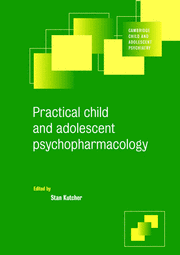Book contents
- Frontmatter
- Contents
- List of contributors
- Preface and acknowledgements
- 1 Child and adolescent psychopharmacology at the turn of the millennium
- 2 Developmental psychopharmacology
- 3 Clinical aspects of child and adolescent psychopharmacology
- 4 Depression
- 5 Bipolar mood disorders: diagnosis, etiology, and treatment
- 6 Schizophrenia and related psychoses
- 7 Obsessive–compulsive disorder
- 8 Anxiety disorders
- 9 Attention-deficit/hyperactivity disorder
- 10 Pervasive development disorder
- 11 Aggressive behavior
- 12 Adolescent substance use disorder
- 13 Tic disorders and Tourette's syndrome
- 14 Eating disorders and related disturbances
- 15 Medical psychiatric conditions
- Index
7 - Obsessive–compulsive disorder
Published online by Cambridge University Press: 31 August 2009
- Frontmatter
- Contents
- List of contributors
- Preface and acknowledgements
- 1 Child and adolescent psychopharmacology at the turn of the millennium
- 2 Developmental psychopharmacology
- 3 Clinical aspects of child and adolescent psychopharmacology
- 4 Depression
- 5 Bipolar mood disorders: diagnosis, etiology, and treatment
- 6 Schizophrenia and related psychoses
- 7 Obsessive–compulsive disorder
- 8 Anxiety disorders
- 9 Attention-deficit/hyperactivity disorder
- 10 Pervasive development disorder
- 11 Aggressive behavior
- 12 Adolescent substance use disorder
- 13 Tic disorders and Tourette's syndrome
- 14 Eating disorders and related disturbances
- 15 Medical psychiatric conditions
- Index
Summary
Despite having been described consistently in the psychiatric literature for close to a century, as recently as 10 years ago, obsessive–compulsive disorder (OCD) was still thought to be a relatively rare condition without a clearly effective treatment. The infrequency of the diagnosis of OCD in clinical settings owed both to the secretive nature of the disorder as well as to under-recognition and misdiagnosis. Recent epidemiologic data suggest that as many as 1–2% of children and adolescents in the United States may meet criteria for OCD. As is the case with adults, children with OCD often suffer silently for many years before they receive assessment, accurate diagnosis, and treatment. With increasing professional and media interest in this disorder and greater sensitivity to its diagnosis, many patients are now being recognized. Additionally, thanks to advances in clinical research, patients with OCD can now expect to receive more effective treatments than were available in the past. In this chapter, we review the current state of knowledge regarding the phenomenology, diagnosis, etiology, and treatment of OCD specifically as related to children and adolescents.
Epidemiology
Initial estimates of the incidence of childhood OCD were made from psychiatric clinic populations. Berman (1942) reported “obsessive–compulsive phenomena” in six (0.2%) of 2800 patients. Similarly, Hollingsworth and colleagues (1980) found 17 cases of OCD (0.2%) in 8367 child and adolescent inpatient and outpatient records.
Keywords
- Type
- Chapter
- Information
- Practical Child and Adolescent Psychopharmacology , pp. 159 - 186Publisher: Cambridge University PressPrint publication year: 2002
- 1
- Cited by



